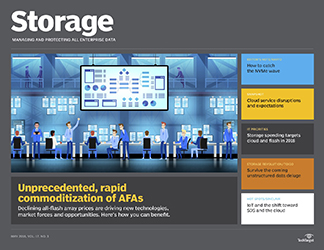PRO+ Premium Content/Storage
Access your Pro+ Content below.
IoT initiatives and other emerging workloads force data center change

This article is part of the Storage issue of May 2018, Vol. 17, No. 3
Transformation has been the main narrative in IT lately. With the rise of the digital economy, the connection between data and business results is stronger than ever. The competitive drive to use data more effectively to push business results, revenue and profitability has led to the popularity of newer workloads that are changing the nature of IT. These workloads include analytics, machine learning, blockchain and the internet of things. It's a wave of transformation substantially different from any we've experienced before and with serious business repercussions for those who don't adapt. The internet of things offers an excellent illustration of how emergent workloads are forcing changes in data center architectures. A quarter of IT decision-makers indicated their organizations have IoT initiatives underway, according to Enterprise Strategy Group's latest IT spending intentions data. This means a quarter of companies already have programs in place to collect data to become more operationally efficient; better monitor products...
Features in this issue
-
Three trends causing the rapid commoditization of AFA storage
Advancing technology and changing market forces have shifted the dynamics in the all-flash array market, opening it up to new challengers and benefiting customers.
-
Many enterprises aren't prepared for a cloud service outage
Some businesses have no idea what a cloud outage will cost them and who takes responsibility for restoring data and workloads, the customer or the cloud service provider.
Columns in this issue
-
NVMe technology is but a first step toward bigger things
NVMe is an inevitable move forward for flash technology that begins the transition to storage-class memory and will lead to even more significant storage advances.
-
Cohesity's hyper-converged secondary storage takes on data growth
An out-of-the-box secondary storage strategy to deal with the coming deluge of file and object data promises to overcome scalability, management and capacity limits of NAS.
